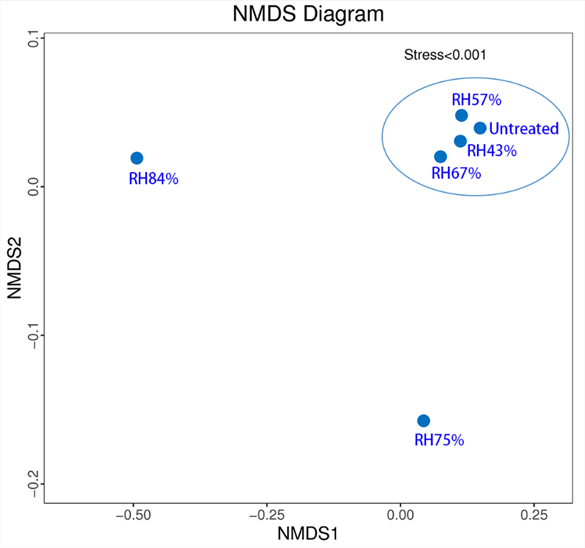China
July 29, 2022
 NMDS analysis showing similarity among fungal populations from kernels of sunflower seeds exposed to various levels of relative humidity (RH) for six months. (Image by LIU Jie)
NMDS analysis showing similarity among fungal populations from kernels of sunflower seeds exposed to various levels of relative humidity (RH) for six months. (Image by LIU Jie)
A research team led by Prof. WU Yuejin from Hefei Institutes of Physical Science (HFIPS) of the Chinese Academy of Sciences (CAS) revealed the source of internal mildew in sunflower seeds for the first time and proposed measures to avoid internal mildewing’s growth and entry of into the food chain.
The relevant results were published in Microorganisms.
Sunflower seeds are rich in unsaturated fatty acids, proteins, and vitamins. During the production process, most internally moldy seeds have a normal-looking shell, which is hard to be recognized and discarded by the naked eye or color-sorting equipment. So far, the source of internal mildew in sunflower seeds has been little investigated, which brings great difficulties to controlling and detecting internal mildew.
 Characteristics of fungal colonies isolated from internally mildewed sunflower seeds. (Image by LIU Jie)
Characteristics of fungal colonies isolated from internally mildewed sunflower seeds. (Image by LIU Jie)
In this research, scientists used high-throughput sequencing to investigate the relationship between microorganisms and internal mildew by accurately characterizing the fungal communities.
The results indicated that almost all the fungal genera identified in the internally moldy sunflower-seed kernels were associated with field infections, representing a total of eight genera and five phyla. And the predominant mildew-causing pathogenic fungi is Alternaria.
Additionally, sunflower seeds are most vulnerable to internal mildew during field-planting stage.
The seeds were usually infected by Alternaria during the seed developmental stage when the humid field conditions were suitable for its multiplication. The internal mildew seeds could lead to Alternaria contamination.
The research team gave their solution. Low humidity conditions during storage could inhibit the growth of Alternaria. After storing below the critical threshold (normal temperature warehouse, relative humidity 65-70%), the microbial community structure of sunflower-seed kernels hardly changed over the six months with the kernels keeping normal appearance.
"A combination of field management to combat Alternaria and drying at the time of storage will minimize or prevent internal mildew," said LIU Jie, first author of the paper.
They also found that for seeds with high water content or in non-primary producing areas with high relative humidity, physical irradiation such as γ-rays before storage can effectively prevent internal mildew.
This research provided an empirical framework for studies of other shelled seeds or nuts, which may reduce the risk of human exposure to internal mildewing.